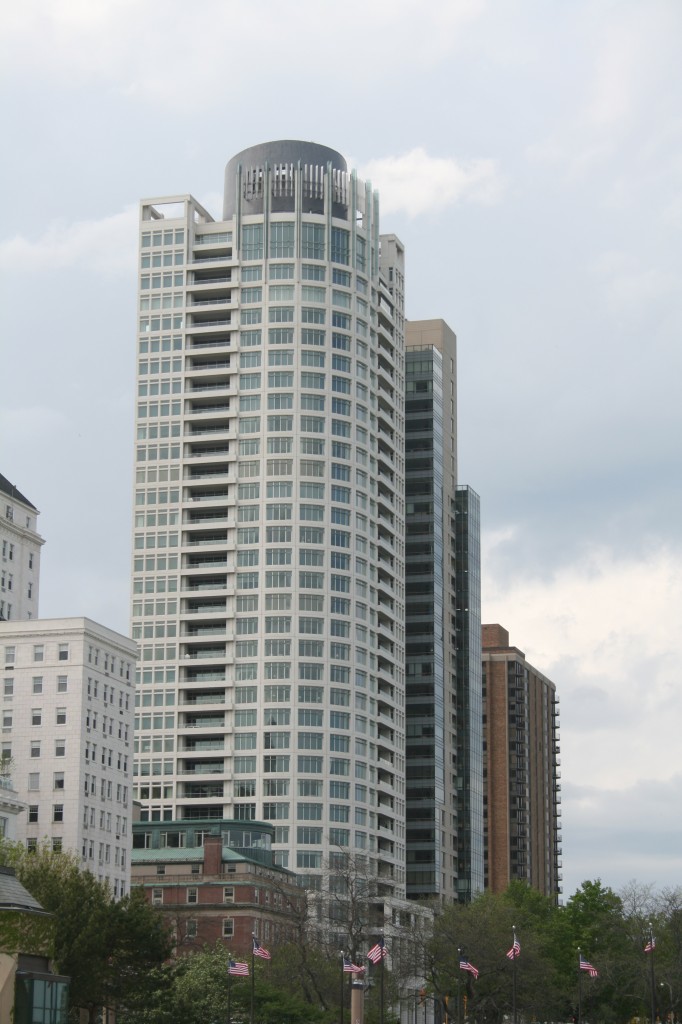City a National Leader in Skyscrapers
Since 2000, Milwaukee ranks 10th among 67 big cities in high-rises built per capita. Part I of a two-part series.

University Club Tower
In the last decade or so, Milwaukee has added a steady stream of high-rise buildings, continuing this trend even after the real estate market crash. There was the 21-story St. John’s on the Lake Tower in 2011 and the 30-story The Moderne in 2012. But how does that compare to other big cities, I wondered.
Searching for answers, I turned to a building construction database available online at the skyscraperpage.com website. This covers nearly 1,300 U.S. cities and includes construction data for nearly all buildings at least 12 stories, or 115 feet tall. Data for each building generally includes the number of floors, principal uses, and dates of construction. I restricted my analysis to buildings of 18 or more stories, partly to reduce the effort needed to evaluate New York City (for which over 5,800 buildings are included in the database) and partly because buildings with fewer stories have less impact on the skylines of most major U.S. cities. I tabulated data for 67 major U.S. cities, with the rank of the cities based on populations as reported in the 2010 census. (I included 17 smaller cities in order to include cities such as St. Louis and Pittsburgh that may no longer rank in the top 50 U.S. cities by population, but are the principal cities of major metropolitan areas and historical centers for high-rise buildings.)
I then ranked the top 25 cities based on the number of buildings of 18 or more stories completed since 2000, which are presented on Table 1. The first ranking shows each city’s ranking only for such buildings built since 2000 and the second ranking is based on the total number of buildings built at any time.
Table 1. Top 25 U.S. Cities for High-Rise Buildings Constructed 2000-13
|
City |
Total New High Rise Buildings Completed (2000-13) |
Rank |
Overall Total High Rise Buildings |
Rank |
|
New York |
281 |
1 |
2,151 |
1 |
|
Chicago |
149 |
2 |
701 |
2 |
|
Miami |
74 |
3 |
130 |
7 |
|
Atlanta |
50 |
T4 |
134 |
6 |
|
Las Vegas |
50 |
T4 |
96 |
11 |
|
Houston |
38 |
6 |
174 |
3 |
|
San Diego |
35 |
7 |
67 |
15 |
|
Seattle |
30 |
8 |
100 |
10 |
|
Dallas |
22 |
T9 |
116 |
9 |
|
San Francisco |
22 |
T9 |
149 |
4 |
|
Boston |
21 |
11 |
89 |
12 |
|
Arlington |
17 |
12 |
47 |
19 |
|
Portland |
14 |
T13 |
41 |
T21 |
|
Austin |
14 |
T13 |
27 |
T32 |
|
Los Angeles |
13 |
15 |
127 |
8 |
|
Philadelphia |
12 |
T16 |
135 |
5 |
|
Charlotte |
12 |
T16 |
31 |
29 |
|
Tampa |
11 |
T18 |
28 |
T30 |
|
Denver |
11 |
T18 |
69 |
14 |
|
Orlando |
11 |
T18 |
27 |
T32 |
|
Milwaukee |
10 |
21 |
40 |
23 |
|
Minneapolis |
9 |
22 |
76 |
13 |
|
Baltimore |
8 |
23 |
51 |
18 |
|
Phoenix |
7 |
T24 |
34 |
T26 |
|
San Jose |
7 |
T24 |
10 |
T50 |
| High rise = 18 stories or greater. Totals are as of June 2013. | ||||
As you can see, Milwaukee’s overall total of 40 high-rise buildings ranks it 23rd among the 67 major U.S. cities evaluated. However, the 10 high-rise buildings completed since 2000 in Milwaukee ranks 21st, with the slightly higher ranking suggesting that Milwaukee is slowly increasing its skyline relative to other major U.S. cities. The 10 high-rise buildings completed in Milwaukee since 2000 include: Sandburg Hall East (2001, 18 stories), 1522 on the Lake (2003, 18 stories), Cathedral Place (2004, 18 stories), Kilbourn Tower (2005, 33 stories), University Club Tower (2007, 35 stories), The Breakwater (2009, 21 stories), Park Lafayette North and South Towers (2009, both 20 stories), St. John’s On The Lake (2011, 20 stories), and The Moderne (2012, 30 stories).
But 10 high-rise buildings completed in Milwaukee since 2000 is arguably more impressive than 13 completed during the same period in Los Angeles (the center of a metropolitan area with over 12.8 million residents), so I decided to “normalize” the data based on populations to better measure the relative intensity of high-rise construction in each of the cities. Thus, I calculated the number of high rise buildings completed during 2000-13 for each city per 100,000 metropolitan area residents in 2010. The resulting population-weighted ratios and rankings for the 15 highest ranked cities are presented in Table 2.
Table 2. Top 15 Cities Based on Number of New High Rise Buildings (2000-13) per 100,000 Metro Area Residents (2010)
|
City |
Metro Area Population (2010) |
Total # of New High Rise Buildings Completed in City (2000-13) |
Rank |
High Rise Buildings Completed (2000-13) per 100,000 Metro Residents (2010) |
Rank |
|
Las Vegas |
1,951,269 |
50 |
T4 |
2.56 |
1 |
|
Chicago |
9,461,105 |
149 |
2 |
1.57 |
2 |
|
New York |
18,897,109 |
281 |
1 |
1.49 |
3 |
|
Miami |
5,564,635 |
74 |
3 |
1.33 |
4 |
|
San Diego |
3,095,313 |
35 |
7 |
1.13 |
5 |
|
Atlanta |
5,268,860 |
50 |
T4 |
0.949 |
6 |
|
Seattle |
3,439,809 |
30 |
8 |
0.872 |
7 |
|
Austin |
1,716,289 |
14 |
T13 |
0.816 |
8 |
|
Charlotte |
1,758,038 |
12 |
T16 |
0.683 |
9 |
|
Milwaukee |
1,555,908 |
10 |
21 |
0.643 |
10 |
|
Houston |
5,946,800 |
38 |
6 |
0.639 |
11 |
|
Portland |
2,226,009 |
14 |
T13 |
0.629 |
12 |
|
Orlando |
2,134,411 |
11 |
T18 |
0.515 |
13 |
|
San Francisco |
4,335,391 |
22 |
T9 |
0.507 |
14 |
|
Boston |
4,552,402 |
21 |
11 |
0.461 |
15 |
Adjusted for metropolitan area populations, Milwaukee’s ranking jumps from 21st to 10th place among the 67 major U.S. cities evaluated. Milwaukee’s ranking is particularly impressive given that it is not the center of a metropolitan area with 4 million or more residents (as is true for Atlanta, Boston, Chicago, Houston, Miami, New York City, and San Francisco), and is not a major tourist destination (as is the case for Miami, Orlando, and Las Vegas). Milwaukee’s “peer” cities that also lack these two key drivers for construction of high-rise buildings include San Diego, Seattle, Atlanta, Austin, Charlotte, and Portland.
The final analysis I performed was to calculate the number of high-rise buildings constructed during 2000-13 per 100,000 person increase in metropolitan area population during 2000-10. The results for the 15 top ranked cities based on this measure are presented on Table 3.
Table 3 – Top 15 Cities Based on the Number of New High Rise Buildings (2000-13) per 100,000 Person Increase in Metropolitan Area Population (2000-10)
|
City |
Metro Area Population Change (2000-10) |
Metro Area % Growth Rate (2000-10) |
Total # of New High Rise Buildings Completed in City (2000-13) |
Rank |
High Rise Buildings Completed (2000-13) per 100,000 Increase in Metro Area Population (2000-10) |
Rank |
|
New York |
574,107 |
3.1% |
281 |
1 |
48.95 |
1 |
|
Chicago |
362,789 |
4.0% |
149 |
2 |
41.07 |
2 |
|
Milwaukee |
55,167 |
3.7% |
10 |
21 |
18.13 |
3 |
|
Miami |
557,071 |
11.1% |
74 |
3 |
13.28 |
4 |
|
Boston |
161,058 |
3.7% |
21 |
11 |
13.04 |
5 |
|
San Diego |
281,480 |
10.0% |
35 |
7 |
12.43 |
6 |
|
Providence |
17,855 |
1.1% |
2 |
T40 |
11.20 |
7 |
|
San Francisco |
211,651 |
5.1% |
22 |
T9 |
10.39 |
8 |
|
Las Vegas |
575,504 |
41.8% |
50 |
T4 |
8.69 |
9 |
|
Seattle |
395,931 |
13.0% |
30 |
8 |
7.58 |
10 |
|
San Jose |
101,092 |
5.8% |
7 |
T24 |
6.92 |
11 |
|
Baltimore |
157,495 |
6.2% |
8 |
23 |
5.08 |
12 |
|
Atlanta |
1,020,879 |
11.1% |
50 |
T4 |
4.90 |
13 |
|
Portland |
298,128 |
15.5% |
14 |
T13 |
4.70 |
14 |
|
Philadelphia |
278,196 |
4.9% |
12 |
T16 |
4.31 |
15 |
On this measure, Milwaukee ranks 3rd among the 67 major U.S. cities evaluated – trailing only New York City and Chicago. Interestingly, 4 of the 5 highest ranked cities, including Milwaukee, Boston, New York City, and Chicago, all had very similar metropolitan population growth rates (ranging from 3.1 to 4.0%). The significance of this measure is probably subject to debate, but high population growth rates unquestionably are more supportive of the construction of additional high-rise buildings in a city than low or negative population growth rates. The decision of Northwestern Mutual to address its future office space needs through a new downtown tower rather than a low-rise building at its Franklin campus may be an example of a dynamic that is occurring more frequently in Milwaukee than in other cities. Milwaukee’s relative performance by this measure is exceeded only by New York City and Chicago, and is potentially unmatched by any other mid-sized U.S. metropolitan area.
To better understand Milwaukee’s performance in a regional context, Table 4 presents a summary of high-rise building completion data for Milwaukee and 14 other major Midwest or commonly cited “peer” cities.
Table 4. High-rise Construction in Major Cities in the Midwestern U.S. (2000-13)
|
City |
State |
Metro Population (2010) |
Metro Area Population Change (2000-10) |
City Population (2010) |
Total High Rise Buildings (2013) |
Total New High Rise Buildings Completed (2000-13) |
U.S. Rank |
New High Rise Buildings Completed (2000-13) per 100,000 Metro Area Residents (2010) |
U.S. Rank |
# of New High Rise Buildings (2000-13) per 100,000 Increase in Metro Area Population (2000-10) |
U.S. Rank |
|
Chicago |
IL |
9,461,105 |
362,789 |
2,695,598 |
701 |
149 |
2 |
1.57 |
2 |
41.07 |
2 |
|
Milwaukee |
WI |
1,555,908 |
55,167 |
594,833 |
40 |
10 |
21 |
0.643 |
10 |
18.13 |
3 |
|
Minneapolis |
MN |
3,279,833 |
311,027 |
382,578 |
76 |
9 |
22 |
0.27 |
T24 |
2.89 |
23 |
|
St. Louis |
MO |
2,812,896 |
114,209 |
319,294 |
43 |
4 |
T29 |
0.14 |
T35 |
3.50 |
16 |
|
Indianapolis |
IN |
1,756,241 |
231,137 |
829,718 |
25 |
3 |
T33 |
0.17 |
T33 |
1.30 |
36 |
|
Cleveland |
OH |
2,077,240 |
(70,903) |
396,815 |
37 |
2 |
T40 |
0.10 |
T40 |
-2.82 |
x |
|
Columbus |
OH |
1,836,536 |
223,842 |
787,033 |
28 |
2 |
T40 |
0.11 |
39 |
0.89 |
39 |
|
Omaha |
NE |
865,350 |
98,309 |
408,958 |
7 |
2 |
T40 |
0.23 |
T27 |
2.03 |
29 |
|
Detroit |
MI |
4,296,250 |
(156,307) |
713,777 |
64 |
1 |
T47 |
0.02 |
49 |
-0.64 |
x |
|
Cincinnati |
OH |
2,130,151 |
120,519 |
296,943 |
34 |
1 |
T47 |
0.05 |
T46 |
0.83 |
41 |
|
Kansas City |
MO |
2,035,334 |
199,296 |
459,787 |
37 |
1 |
T47 |
0.05 |
T46 |
0.50 |
47 |
|
Louisville |
KY |
1,283,566 |
121,591 |
741,096 |
19 |
1 |
T47 |
0.08 |
T42 |
0.82 |
42 |
|
Oklahoma City |
OK |
1,252,987 |
157,566 |
579,999 |
14 |
1 |
T47 |
0.08 |
T42 |
0.63 |
45 |
|
St. Paul |
MN |
3,279,833 |
311,027 |
285,068 |
20 |
0 |
T53 |
0.00 |
T50 |
0.00 |
T49 |
|
Des Moines |
IA |
569,633 |
88,239 |
203,433 |
9 |
0 |
T53 |
0.00 |
T50 |
0.00 |
T49 |
There’s a lot of data in this table, but the bottom line is that Milwaukee ranks ahead of every other Midwest or peer city except Chicago in all categories. Minneapolis is the only other city in the Midwest to rank even close to Milwaukee in a post-2000 high-rise building completion category. Remarkably, more high rise buildings have been completed this century in Milwaukee than in the cities of Des Moines, St. Paul, Oklahoma City, Louisville, Kansas City, Cincinnati, Detroit, Omaha, and Columbus combined.
Nor is there reason to think this momentum in Milwaukee is slowing. The trend of one new high rise building being completed in Milwaukee approximately every 1.25 years appears likely to continue over at least the next 5 years, with the 18-story Potawatomi Bingo Casino Hotel Tower scheduled for completion in 2014, the 18-story 833 East Michigan building and 33-story (or higher) NML Tower likely to begin construction within the next two years, and plans advancing for projects such as the proposed 44-story The Couture tower and the 19-story Bookends North development.
Milwaukee’s 21st century performance in the construction of high-rise buildings has been remarkably strong relative to other major U.S. cities, both nationally and even more so in the Midwest. And among “slow growth” metropolitan areas having 2 million or fewer residents, Milwaukee’s performance appears to be unmatched.
Why has the city done so well? Hard to say for sure. Certainly former mayor John Norquist helped put into place policies that helped jump start residential development in Milwaukee. But I’m convinced the city’s stellar performance is likely attributable to the exceptionally high-quality urban environment that has been created in Milwaukee’s downtown lakefront, and near downtown neighborhoods. Milwaukee’s peer group for this highly visible and economically significant component of the urban built environment appears to consist of cities such as San Diego, Seattle, Austin, Charlotte, and Portland as well as much bigger metro areas such as New York City, Chicago, Boston and Atlanta. Not bad company to keep.
Coming Next: How extraordinary is the proposed 44-story The Couture on a national basis?
David Holmes, a resident of the Milwaukee area for over 40 years, is an environmental scientist and grant writer specializing in the assessment, cleanup, and redevelopment of brownfield sites. He is currently pursuing a doctoral degree in Freshwater Sciences at UW-Milwaukee. In 2008, he coauthored a book, “Chinese Milwaukee,” on the history of the Chinese community in Milwaukee.





















I love statistics. That is all…
Interesting stuff. I’m curious as to why in tables 2 and 3 you calculate “per capita skyscrapers” using separate geographies (metro area population vs. skyscrapers within the city). For Milwaukee the distinction holds that all skyscrapers in the metro area are located within the city (Park Place notwithstanding), but larger cities like New York and Chicago have a number of tall buildings in farther out “edge city” communities. For example, I-88 in Oak Brook, IL has a number of tall buildings that wouldn’t look out of place in downtown.
I find it interesting that the author chose to use the height of 18 floors for the article. It seems to create a very pro-Milwaukee set of statistics since a lot of the buildings constructed in Milwaukee are 18 floors. I wonder how much the chart would have changed if he instead used 19 floors. Also, it would be nice if he factored in the high of the buildings being constructed. With his methodology a city which built 1 70 floor tower would rank lower than a city which built 2 18 floor buildings.
The tallest building in Milwaukee would be the 36th tallest building in Chicago.
Along with all of the new hi-rise buildings a lot of buildings shorter than the 18 story skyscraper height have been added in the city since 2000. If you do a study on that you will probably find that the 3rd Ward, Commerce Street, Brewers Hill along and south of Brown Street and various infill developments in the North Avenue/Lower East Side and the 5th Ward/Walker’s Point areas are per capita growing at a much faster pace than most large cities in the Midwest. It really proves that the neighborhoods immediately surrounding the Downtown area are growing too.
As GT indicates, the sprawl effect in larger metro areas tends to encourage development outside of the central city at times. In the St. Louis area, development in the county seat of Clayton and along I-270 in western St. Louis County are at least somewhat of a factor in the relative paucity of new high rises built in the downtown over the last decade or so. The lake in Milwaukee is also a huge asset in drawing development of high rises for the lake view. The Mississippi River flowing past downtown St. Louis hardly compares in this respect, and while the Gateway Arch is nice, it can be seen from miles away.
Nearly all of the high-rise construction in Milwaukee that you cite is expensive residential within striking distance of Lake Michigan. So, perhaps, a large driver of the construction consists of aging, well-off baby boomers, their children grown and gone, seeking an alternative to the skull-shattering boredom of the suburbs they had called home. But trading one over-built residence for another is no great turning point for the area. I’ll be convinced the city is on a sustainable residential development path when investment is centered not on over-indulged luxury but, instead, on revitalization of the community’s large stock of modest homes and neighborhoods, the places that most of the city’s residents call home.
Just saw this story in the online version of the local paper. It’s possible someone else is in the wings planning to move in, but this is the 3rd tallest structure in St. Louis and has a large AT&T logo on the exterior near the top. That AT&T has decided to move everyone out of such a nice and modern building less than 30 years old says much about how poorly downtown St. Louis is doing compared to the downtown areas in cities such as Milwaukee in regard to building high rises.
http://www.stltoday.com/business/local/at-t-to-vacate-downtown-st-louis-high-rise-next/article_7f20c54a-5daf-57d7-9efb-ebd52a464364.html